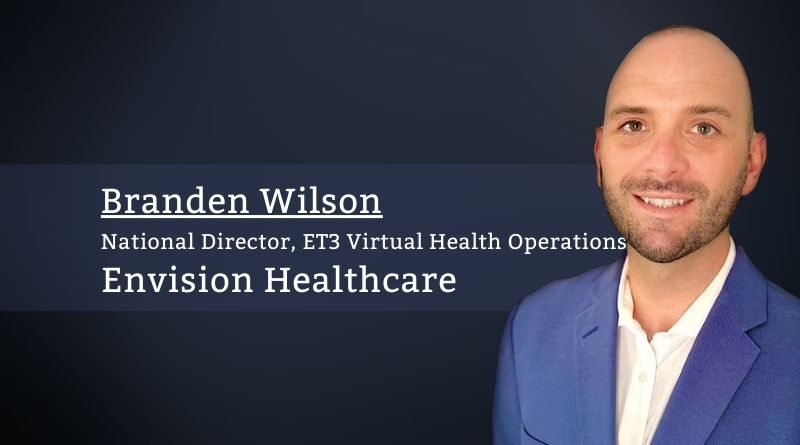Healthcare Technology is Transforming the Industry
By Branden Wilson, National Director, ET3 Virtual Health Operations, Envision Healthcare
Even before the COVID-19 pandemic, healthcare consumers sought convenient, more affordable ways to access healthcare. The pandemic rapidly accelerated this trend, encouraging healthcare organizations to develop and deploy patient-centered telemedicine services that gave consumers what they wanted. Due to its versatility, accessibility and cost-effectiveness, I believe consumer demand for telemedicine will only continue to increase.
After witnessing the need for more telemedicine in the early pandemic, Envision increased its investment in and deployment of virtual services to include teleneurology, maternal-fetal medicine, transitional care, neonatology and direct-to-consumer occupational medicine, among many others.
To effectively deliver virtual care, organizations must collaborate with technology companies to create platforms that are easy for both patients and clinicians to use.
One of the programs we’re proudest of is our ET3 virtual emergency medicine program, which launched in January 2021 with our strategic partner, Global Medical Response (GMR) and other EMS agencies. We are now active with the program in 17 states across the U.S. ET3, or Emergency Triage, Treat and Transport, is a voluntary initiative in partnership with the Centers for Medicare & Medicaid Services (CMS) that incentivizes appropriate utilization of emergency medical services. Coupled with Community Paramedicine (CP), which dispatches a caregiver following non-emergent 911 calls, these programs deliver a patient-centered emergency response by supporting the right care at the right time in the right place.
Our Virtual Health Services team uses two-way, real-time audio/video on mobile devices to bring local emergency medical services (EMS) responders together with Envision’s national network of more than 60 EMS medical directors and 3,500 board-certified emergency medicine clinicians. We serve more than 100 U.S. counties and 20 million patients in the ET3 program.
Challenges transitioning from brick-and-mortar to virtual
With the numerous virtual health technology platforms available, it can be challenging to find the right platform that meets the exact functionality required for a given service while having the right level of configuration to match the needs of Envision’s virtual health programs.
Using our ET3 care program as an example, Envision’s leading team of clinical and operational experts worked closely with our platform vendor to develop functionality beyond “out-of-the-box” features. The results were new technology features and workflows that allowed for streamlined platform functionality while focusing on the patient-clinician experience. Partnering with a high-quality technology vendor that is willing to collaborate with your organization and take an innovative approach to their platform’s features is critical.
In addition to being functionally flexible, virtual health platforms must be easy for providers to use. The technology must work as intended. Otherwise, the platform may create challenges that can lead to underutilization. I often find myself saying that we have to make the virtual “front door” easy for patients to walk through. We have a responsibility to provide them with a positive care experience. Any virtual service must be easy to access and use. Complex registration and login processes or connectivity issues related to audio and video functionality will only create user frustration and, over time, a lack of patient utilization.
Embracing emerging healthcare technologies
To ensure our virtual health platforms like the one used for ET3 provide a positive experience, we routinely ask patients for their feedback. A patient recently explained that they were hesitant to call 911 as they did not want to go to their local emergency department. The EMS team, in partnership with an Envision emergency physician, assessed and treated the patient via a virtual emergency visit. With the patient’s health and safety top of mind, the care team determined the patient’s condition was not high risk and it was not clinically necessary for the patient to go to the ED. The patient told us, “I can’t believe I was able to speak to an ER physician from my living room couch. My family and I are so grateful we didn’t have to go to the emergency room.”
When I think about the positive benefits of emerging virtual health capabilities, I think about the real impact we have on patients’ lives. With the help of technology, we are helping patients access the most appropriate care when and where they need it most.
Naturally, embracing and implementing emerging technologies comes with a learning curve. Telemedicine regulations at the federal and state levels were expanded dramatically during the COVID-19 pandemic. However, the need for permanent legislation still exists for everything from interstate licensure compacts to telemedicine reimbursement dynamics. Public and commercial health insurers must also keep up with the demand from consumers and the need to reimburse clinicians.
While virtual healthcare expands patients’ access to care, improves patient outcomes and drives healthcare costs down, how quickly and to what extent this takes place will be influenced by regulatory and insurer dynamics.
I am confident that virtual care is the future of healthcare delivery. Consumer demand for more convenient, low-cost service models is here to stay and will only increase with time as consumers become more selective in how they access care. To effectively deliver virtual care, organizations must collaborate with technology companies to create platforms that are easy for both patients and clinicians to use.
As the healthcare system continues to evolve, more providers will likely adopt or expand virtual health capabilities. Those providers that are open to embracing innovative changes and virtual services are better suited to meet patients’ unique and ever-changing needs.



